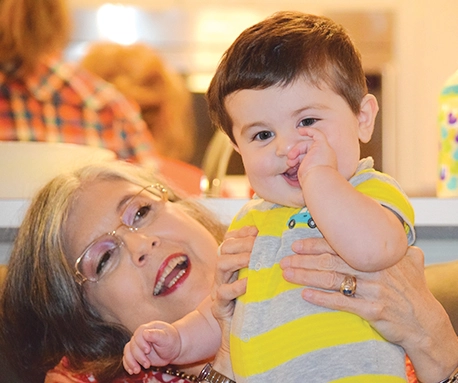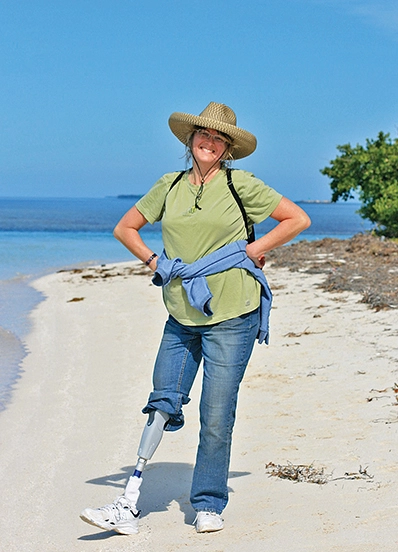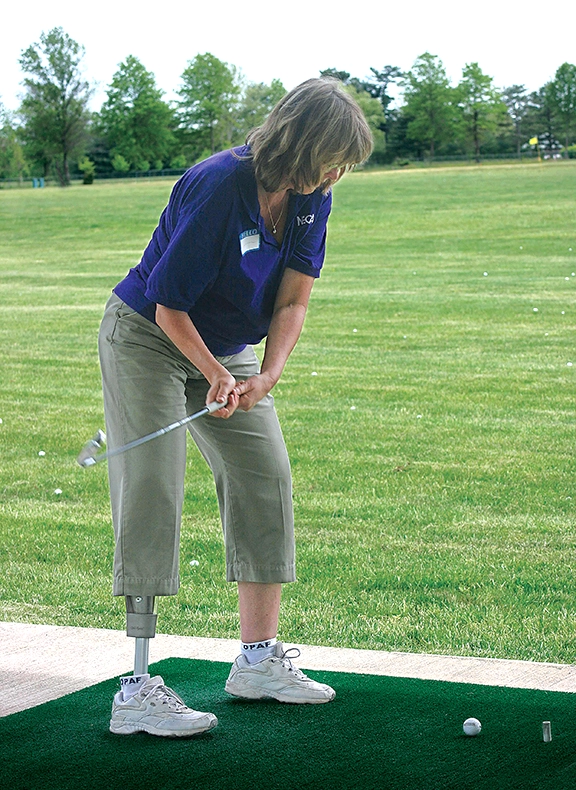By Abbey Smith
For many lower-limb amputees, the risk of falling—and potentially injuring themselves—is a very real possibility. A little know-how and preparation, however, can lower the chances of a serious fall and help prevent injuries.
Prevention Is Better Than a Cure
According to the National Safety Council, most falls happen in homes and other private property, which is why fall prevention usually starts with creating a safe living environment.

“Many falls in the home happen because items aren’t properly stored or put away,” says Kevin Carroll, MS, CP, FAAOP(D), vice president of prosthetics at Hanger Clinic, headquartered in Austin, Texas. “Equipping your house to prevent injuries is a good investment in your future and safety.”
He suggests asking a physical therapist (PT) to evaluate your house for potential tripping hazards, such as uneven carpeting and floorboards, and suggest modifications to increase safety, such as installing handrails in stairwells and hallways. Other critical areas to evaluate are the bathroom and kitchen, which are often the most dangerous rooms in your home due to slick floors and throw rugs that can easily slide. Carroll says other areas where amputees are more prone to fall include restaurants and grocery stores, which can have slippery floors, and new or unfamiliar environments, such as a friend’s home.
Carroll also emphasizes the importance of exercise and physical therapy. These activities build muscles that provide extra support around the hips, legs, and knees to help prevent serious injuries.
“A trained professional, such as a certified athletic trainer or physical therapist, can create or modify an exercise program specific to an amputee’s needs and abilities,” he says. “Yoga also can be beneficial for many amputees when it comes to strengthening.”
We All Fall Down
Because not all accidents can be prevented, knowing how to fall safely can help amputees avoid serious injuries. Amputees, including those with years of experience, can benefit from regularly practicing these techniques with a PT.

Image by Andrew Piazza.
“Once you remove the fear of falling, you’ll have more peace of mind,” Carroll says. “You’ll be better able to navigate new and different terrains that you may have previously avoided.”
The Centers for Disease Control and Prevention (CDC) reports that millions of people are treated in emergency departments because of falls. While the severity of a fall varies depending on the person and situation, the CDC estimates that one out of five falls causes a serious injury, such as a broken hip or traumatic head injury. That’s why it’s critical to know what to do after a fall has occurred.
“You can’t just get up after a fall,” Carroll says. “You need to assess your situation to make sure you’re okay. Moving could do a lot more damage if you’ve sustained injuries.”
You also need to tell your PT, prosthetist, and doctor about your fall so they can help you prevent future accidents.
“We all fall at some point in our lives, so don’t be scared or embarrassed to ask for help,” he says. “Remember, live life to its fullest.”
Liz Piazza: Wet Floors Versus Assistive Devices
The morning started out like any other day for Elizabeth A. “Liz” Piazza, PharmD, a retired pharmacist. She woke up, grabbed her crutches, and headed to the kitchen. Unbeknownst to Piazza, however, her son’s friend had spilled a pitcher of orange juice on the floor the previous evening and had attempted to clean it up with water, which left the floor slick.
“I walked into the kitchen and fell,” says Piazza, who lost her right leg above the knee in 1968 due to cancer. “I hit the end of my femur and felt unbelievable pain. I tried to brace myself after falling, but continued to slide across the floor, hearing my right hip break.”
Even though a surgery was necessary that required three screws to be inserted in the neck of her femur, her positivity and sense of humor remained—so much so that she even threw herself a party after she recovered.

Image by Capt. Victoria Impallomeni.
“The fall affected me emotionally, but I told myself that everything was going to be okay,” says Piazza. “I was more concerned about walking again and things going back to normal.”
After her accident, she worked with a PT, who helped her regain strength and massaged the adhesions in her hip to ensure her prosthesis fit comfortably. She also relied on her strong faith to help guide her through the healing process.
Piazza—who only uses crutches when first getting up, going to bed, and showering—says that while anyone could have slipped on the kitchen floor, being on crutches made her more susceptible to falling. As a result, she now takes extra measures to ensure her safety if it’s raining or if she sees signs warning about wet floors. She also works with a personal trainer and swims to stay in shape.
In 2003, three years after breaking her hip, Piazza experienced another accident while putting up Christmas decorations at her house. She was standing on her front porch, which was wet, when her prosthesis slipped behind her. She tried regaining balance with her left leg, but fell on her ankle and broke it.
“That accident severely limited by mobility, and I was anxious to get back to my prosthesis,” says Piazza, who has since recovered from the accident. “It’s scary not knowing what’s coming next, and I think I would have benefitted from speaking to others who could relate to my experience and share their perspectives with me.”
As a result of realizing what would have helped her during her own recovery process, Piazza now regularly shares her story to provide support and inspiration for those who have experienced similar injuries.
Susan Lazarchick: Trying to Focus on the Positive
In 1987, after nine months and two misdiagnoses, Susan Lazarchick was diagnosed with a benign giant cell bone tumor the size of a grapefruit that had destroyed her upper tibia and part of her knee in her right leg. Rather than have her leg amputated, she opted to have a knee transplant, which was the first of its kind. At 32, Lazarchick had landmark limb salvage surgery, and received the knee of an 18-year-old man who had died in a motorcycle accident.
During the next 20 years, Lazarchick managed fairly well; however, as the cadaver ligaments in her knee began to stretch out, she needed two more knee replacements. In 2006, her knee became infected and, after multiple unsuccessful attempts to save her leg during the following six months, her right leg was amputated above the knee.
With the love and support of her family, Lazarchick adapted to life as an amputee and eventually returned to work—where, in June 2014, she suddenly fell backward and suffered a burst compression spinal fracture. As a result of her injury, she required medical treatment from a spine specialist and was confined to wearing a clamshell brace for nearly six months while her spinal column healed.

Image by Andrea Verone.
Furthermore, her prosthetist, whom she still visits on a regular basis, inserted an offset plate above her knee so there was less torque on her back. She also attended an outpatient rehabilitation program to increase her core strength before returning to her regular PT. Her PT focuses on working with amputees and makes it a priority to work closely with Lazarchick’s prosthetist.
“I was afraid of hurting my back further,” Lazarchick says. “It took almost a year before I really started feeling strong again, but I feel I’m not walking as well as I was before the accident. I’m using a cane about 75 percent of the time now, whereas I was using it maybe 20 percent of the time before the accident. That’s very discouraging, but I try to take positive actions and not dwell on what I cannot do.”
To help regain her confidence, Lazarchick returned to counseling, listens to motivational recordings, and studies mindfulness-based stress reduction (MBSR), which combines meditation, yoga, and body awareness to help people manage pain and reduce stress. She’s also added safety precautions that include carrying her cell phone almost everywhere and using either a cane or a set of Nordic walking poles, depending on the terrain and trip distance. In addition to using high-quality crutch tips, she uses grab bars on her toilet and a shower chair to help prevent falls.
“Even though I have gone through some very difficult times, I have developed some resilience,” says Lazarchick, who credits Michael, her husband of 40 years, for supporting her and helping her live as normally as possible. “Being involved in the amputee community has helped me a lot to realize that I’m not the only one going through these difficulties and that there is life after amputation.”
Lazarchick continues to focus on the positive and does things that make her happy. She and her husband have been raising Labrador retrievers for 20 years, and she’s also an obedience training instructor. Recently, she had one of her dogs certified as a therapy dog that she’s planning to take to one of her upcoming support group meetings. She’s also a beekeeper, raises chickens, and enjoys organic gardening.
In addition, as part of her efforts to remain active over the years, she’s participated in many of the free sports and recreational events that the Orthotic and Prosthetic Activities Foundation (OPAF) holds around the country (www.opafonline.org). OPAF’s goal, through its introductory First Clinics, is to provide activities that everyone can enjoy in a nurturing, safe, noncompetitive, nonjudgmental environment.
“The First Clinics have helped encourage me immensely over the years,” Lazarchick says, “and now that I’m starting to feel stronger, I look forward to being able to participate in them again.”



